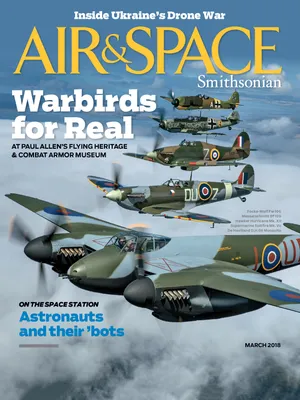The 25 Most Influential Aircraft of All Time
A new book lists the best of the best.
:focal(1675x1446:1676x1447)/https://tf-cmsv2-smithsonianmag-media.s3.amazonaws.com/filer/c3/e8/c3e877f5-0780-491a-8753-e9728a263888/nasm-9a02391.jpg)
In their new book, The 25 Most Influential Aircraft of All Time, Walter J. Boyne and Philip Handleman—both of whom are pilots and historians—write insightfully about what they consider the most significant airplanes in history, including the Bell X-1, the Learjet, and the Mitsubishi Zero. Part of the pleasure of reading their list is noting which aircraft did not make it. Boyne and Handleman spoke with senior associate editor Diane Tedeschi in December.
Air & Space: Why did you decide to write this book?
Handleman: Both Walt and I have read lots of books on the history of aviation, and we felt that a new way to tell the story of flight would be to use a number of iconic aircraft as a window onto the subject. Our approach focused on the particular in the hope of revealing the universal.
What are some of the requirements that had to be met for an aircraft to make the list?
Boyne: The requirements for inclusion were a combination of several elements. Some of these were obvious while some were subtle and, admittedly, subject to personal preference. Our metrics included operating performance, market acceptance, mission achievements, contributions to technological development, impact on subsequent designs, and the grip each candidate aircraft had on the popular imagination. Another aspect that factored into our assessments was the consensus view of aviation historians; we found that at least half of the aircraft on our list appear on just about everyone else’s list.
“Influential” is a subjective term and thus not reducible to easily quantifiable data. The advantage for us as the authors is that it rendered leeway in our choices. On the flip side, it means that readers have equal latitude to question our selections. It is actually a debate we welcome, as we recognize there are no absolutes in this process. In the end, we defined influence to mean the power to affect outcomes and perceptions. An example from our list of the most influential aircraft is the DC-3, the breakthrough commercial transport in the 1930s that offered airlines improved load factors and profitability while gaining public acceptance through enhanced cost efficiencies and safety. The type set a new industry standard and, yes, influenced both design philosophy through the advent of jet propulsion and passenger expectations for the remainder of the propeller era.
What is your favorite aircraft on the list?
Handleman: Well, this is like asking parents to name their favorite child. Like most pilots, we developed attachments to the airplanes we have regularly flown. For me that would be the Stearman, the World War II open-cockpit biplane that introduced thousands of prospective aviators to the fundamentals of airmanship.
Of the aircraft on your list, which was the most challenging to design?
Handleman: Undoubtedly, it was the Wright Flyer. Wilbur and Orville had no preexisting template with which to work. They were discovering the underlying science in parallel with the development of their flying machine.
Name an aircraft you didn’t have room for.
Boyne: A whole host of admired aircraft were excluded, but one that really causes the heart to throb is the Curtiss C-46. The C-46 was a big, awkward aircraft, difficult to fly over high terrain when lightly loaded, deadly to fly heavily loaded over high terrain after losing an engine. It was also a workhorse that served in many theaters, and it might be said to have sustained the Chinese Nationalist government for many months of World War II.
The aircraft we anguished over most in our decision-making was the Lockheed SR-71 Blackbird. The Mach 3 reconnaissance platform certainly has a legion of loyal fans, and understandably so since it could outfly any other manned air-breather. But the interceptor version proved to be a nonstarter, and, for all its qualities, the aircraft proved too costly for continued operations, forcing its retirement while the plane it was meant to replace, the U-2, soldiers on even to this day. In the couple decades since the SR-71 was retired, no other similar type is known to have entered operational service, although Lockheed has signaled that a hypersonic follow-on, the SR-72, is in the works.
Only 24 years separates the design of the Wright Flyer and the Spirit of St. Louis, yet they look nothing alike. Are you impressed by the pace of aeronautic design in the early years?
Boyne: The progress of aeronautic design was dramatic, an effect augmented by the willingness of designers to steal and improve upon the work of others. A slide show of aircraft improvements—year by year, country by country—would show a migration of ideas from one source to another with little, if any, consideration of patent rights. An important factor in this was the multiplicity of small firms that national governments sustained in business as a security measure, making sure there were many sources that could rapidly expand production in the event of a national emergency and protecting them from worries about patent infringement.
What is your opinion of drone aircraft?
Boyne: Drone aircraft are a magnificent new path, and every combat aircraft should be a drone, thereby keeping human aircrew out of death’s way. Technology is approaching this point, and in less than 20 years manned combat aircraft should be a thing of the past.
